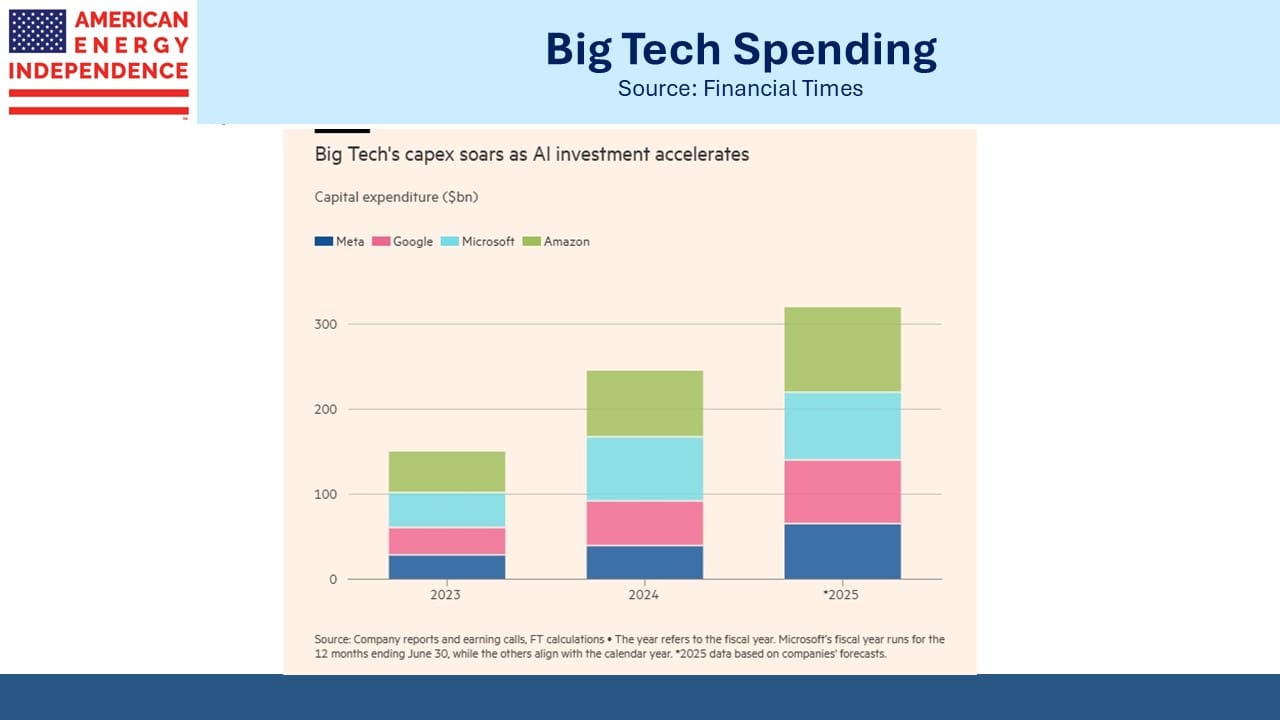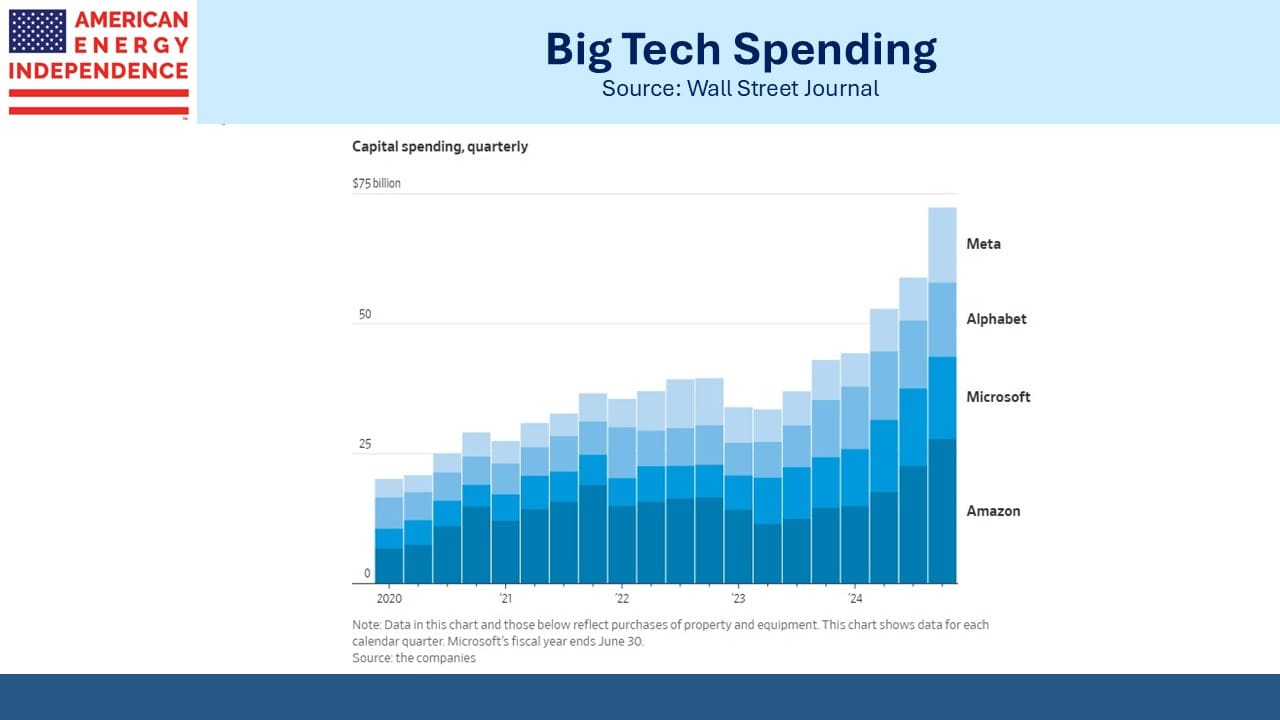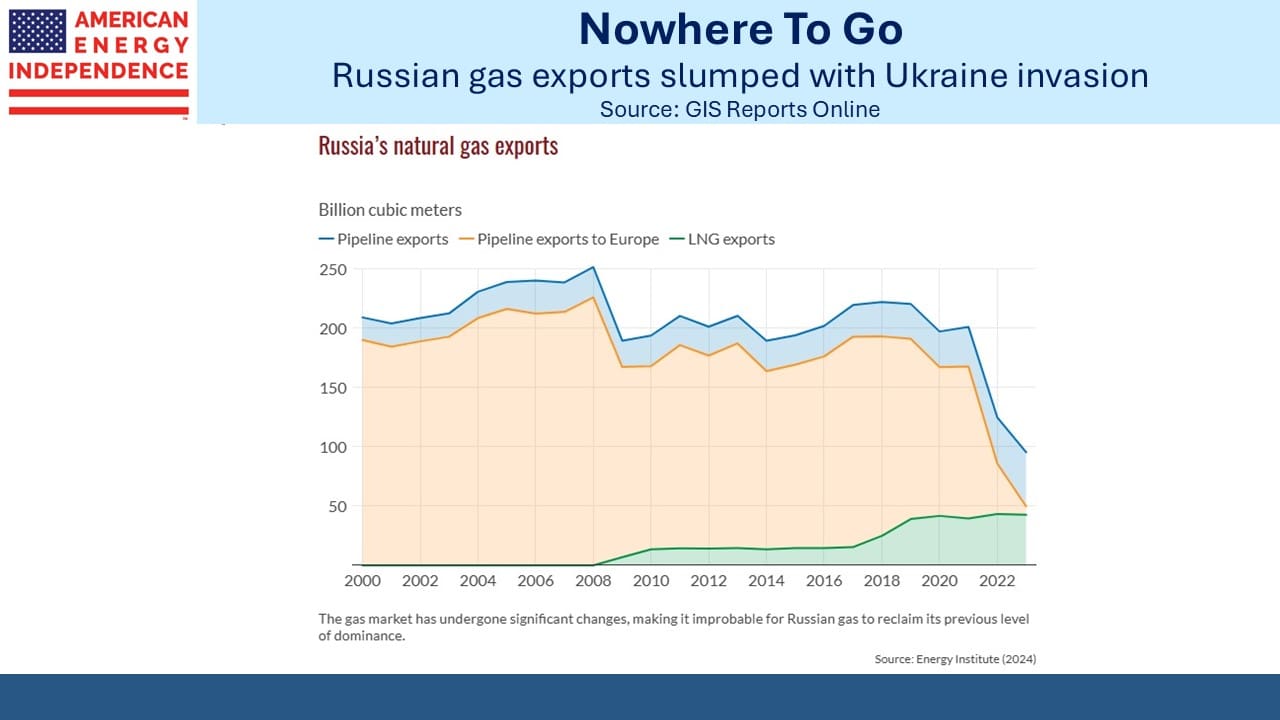Hyperscalers Plow Ahead

/
On Friday both the Wall Street Journal and the Financial Times ran stories about planned capex on data centers by the big US tech companies. The DeepSeek news of two weeks ago hasn’t resulted in any discernible change. The case for increased power generation remains intact.
On Wednesday Williams Companies will report their quarterly earnings. They have hinted that they may announce a “behind the meter” (BTM) deal to provide natural gas for a dedicated power station co-located with a new data center. They have in the past said there are numerous discussions under way. BTM arrangements bypass the existing grid, which speeds up approvals and installation.
Electricity grids operate with high fixed costs that are broadly shared across customers, commensurate with their usage. Adding significant new infrastructure to accommodate growth in demand spreads that new expense across the user base, in effect subsidizing the new users at the expense of the existing ones. Regulators will look carefully at this to ensure rates don’t go up unreasonably.
Talen Energy and the PJM grid plan to provide nuclear power to a new data center being built by Amazon Web Services. FERC rejected the agreement, finding it was potentially adverse to utility customers because it would require additions to the existing grid infrastructure and possibly increase rates for everyone. BTM is a way to avoid that.
However, it means the data center is exposed to downtime on its co-located power source. Natural gas combined cycle power plants typically run 95% of the time, far better than the 20-35% common with solar and wind, which is why renewables aren’t much use to data centers. Nonetheless, even 5% downtime for maintenance leaves a coverage gap that a grid connection could otherwise alleviate. As further announcements are made we’ll see how the industry is addressing the challenge.
Liquefied Natural Gas (LNG) stocks slipped last week on reports that the White House is negotiating directly with Russia to end the war in Ukraine. There’s some speculation that the conclusion of hostilities could prompt a resumption of EU imports of natural gas from Russia, reducing the need for US LNG.
The Nord Stream gas pipelines that sent Russian gas to Germany rank up there among the dumbest energy policies in history. Trump railed against this dependency during his first term in office, rightly asking why US troops were stationed in Germany to protect against an attack from their gas supplier. Since the invasion Russia’s natural gas exports have fallen by more than half. It has struggled to find buyers and to get its gas to market.
We think any natural gas agreement as part of a Ukraine ceasefire is more likely to embed EU imports from the US not Russia. Thoughtful European policymakers won’t want to repeat the misplaced trust in Russia of former German Chancellor Angela Merkel, who should be spending her retirement giving speeches apologizing for her strategic blunders.
Venture Global (VG) has traded off sharply since its IPO. The market is applying a management discount based on how they’re perceived by customers. Last week Total CEO Patrick Pouyanné said they decided not to become a long term buyer of LNG from VG because they didn’t trust the company. This was in spite of the attractive terms being offered.
Once an LNG “train” or export facility is fully commissioned it is generally expected to begin shipping LNG under the terms of its long term contracts. VG’s interpretation of commissioning for its Calcasieu Pass terminal has resulted in a dispute over $BNs in profits that Shell, BP, Galp and Repsol believe they should have earned. VG said the terminal wasn’t complete, allowing them to reap huge profits following the spike in gas prices after Russia invaded Ukraine (see Nothing Ventured, Nothing Gained).
The dispute is in arbitration. Even if VG prevails, their reputation is in shatters. Some of the biggest buyers of LNG won’t do business with them. Even if they do, it’s likely that they’ll negotiate from the perspective that good faith isn’t in the VG lexicon.
Add to this VG’s initial IPO price target which would have valued the company at over $100BN, more than double Cheniere who handles half of America’s LNG exports. Even at its greatly reduced IPO price it was still, briefly, the most valuable publicly listed LNG company. Since then it’s slumped, to the chagrin of IPO buyers who are down by a third.
It seems that if VG shows you an attractive LNG export proposal, you’re supposed to be wary. And if the founders want you to buy some of their stock, the profitable move is to go short.
Founders Michael Sabel and Robert Pender have become billionaires while alienating a lot of key industry figures. VG’s management discount to its valuation is going to be around for a long time.
We have two have funds that seek to profit from this environment:

Important Disclosures
The information provided is for informational purposes only and investors should determine for themselves whether a particular service, security or product is suitable for their investment needs. The information contained herein is not complete, may not be current, is subject to change, and is subject to, and qualified in its entirety by, the more complete disclosures, risk factors and other terms that are contained in the disclosure, prospectus, and offering. Certain information herein has been obtained from third party sources and, although believed to be reliable, has not been independently verified and its accuracy or completeness cannot be guaranteed. No representation is made with respect to the accuracy, completeness or timeliness of this information. Nothing provided on this site constitutes tax advice. Individuals should seek the advice of their own tax advisor for specific information regarding tax consequences of investments. Investments in securities entail risk and are not suitable for all investors. This site is not a recommendation nor an offer to sell (or solicitation of an offer to buy) securities in the United States or in any other jurisdiction.
References to indexes and benchmarks are hypothetical illustrations of aggregate returns and do not reflect the performance of any actual investment. Investors cannot invest in an index and do not reflect the deduction of the advisor’s fees or other trading expenses. There can be no assurance that current investments will be profitable. Actual realized returns will depend on, among other factors, the value of assets and market conditions at the time of disposition, any related transaction costs, and the timing of the purchase. Indexes and benchmarks may not directly correlate or only partially relate to portfolios managed by SL Advisors as they have different underlying investments and may use different strategies or have different objectives than portfolios managed by SL Advisors (e.g. The Alerian index is a group MLP securities in the oil and gas industries. Portfolios may not include the same investments that are included in the Alerian Index. The S & P Index does not directly relate to investment strategies managed by SL Advisers.)
This site may contain forward-looking statements relating to the objectives, opportunities, and the future performance of the U.S. market generally. Forward-looking statements may be identified by the use of such words as; “believe,” “expect,” “anticipate,” “should,” “planned,” “estimated,” “potential” and other similar terms. Examples of forward-looking statements include, but are not limited to, estimates with respect to financial condition, results of operations, and success or lack of success of any particular investment strategy. All are subject to various factors, including, but not limited to general and local economic conditions, changing levels of competition within certain industries and markets, changes in interest rates, changes in legislation or regulation, and other economic, competitive, governmental, regulatory and technological factors affecting a portfolio’s operations that could cause actual results to differ materially from projected results. Such statements are forward-looking in nature and involves a number of known and unknown risks, uncertainties and other factors, and accordingly, actual results may differ materially from those reflected or contemplated in such forward-looking statements. Prospective investors are cautioned not to place undue reliance on any forward-looking statements or examples. None of SL Advisors LLC or any of its affiliates or principals nor any other individual or entity assumes any obligation to update any forward-looking statements as a result of new information, subsequent events or any other circumstances. All statements made herein speak only as of the date that they were made. r
Certain hyperlinks or referenced websites on the Site, if any, are for your convenience and forward you to third parties’ websites, which generally are recognized by their top level domain name. Any descriptions of, references to, or links to other products, publications or services does not constitute an endorsement, authorization, sponsorship by or affiliation with SL Advisors LLC with respect to any linked site or its sponsor, unless expressly stated by SL Advisors LLC. Any such information, products or sites have not necessarily been reviewed by SL Advisors LLC and are provided or maintained by third parties over whom SL Advisors LLC exercise no control. SL Advisors LLC expressly disclaim any responsibility for the content, the accuracy of the information, and/or quality of products or services provided by or advertised on these third-party sites.
All investment strategies have the potential for profit or loss. Different types of investments involve varying degrees of risk, and there can be no assurance that any specific investment will be suitable or profitable for a client’s investment portfolio.
Past performance of the American Energy Independence Index is not indicative of future returns.






Leave a Reply
Want to join the discussion?Feel free to contribute!